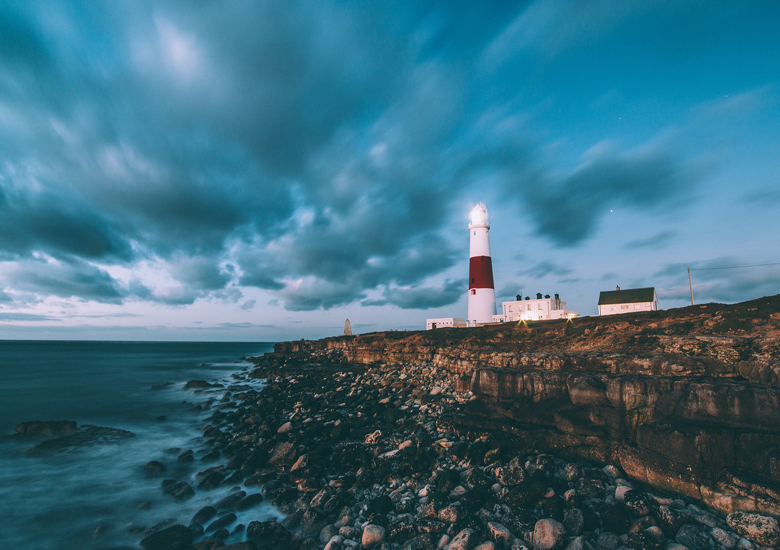The Portland Bill Lighthouse is a lighthouse in England on the Isle of Portland , Dorset, England, – United Kingdom , in the English Channel.
The lighthouse directs the ships around the southeastern sand banks Bill and Shambles through the strong tidal currents dominated fairway to the port of Weymouth. In addition, it is a landmark for ships in the English Channel. It is operated and maintained by the Trinity House Lighthouse Service, the official English authority responsible for the maintenance of lighthouses and other shipping signs.
The two original lighthouses, now known as the Old Higher Lighthouse and Old Lower Lighthouse, operated as a pair of leading lights to guide ships between Portland Race and The Shambles sandbank . In the early eighteenth century, some shipowners and the city of Weymouth petitioned Trinity House to build a lighthouse to facilitate navigation around the Isle of Portland. However, Trinity House considered a tower at this location to be unnecessary and rejected the construction. Further efforts eventually resulted in a commission from May 26, 1716 by Georg I to build a tower at Trinity House. This awarded the contract for 61 years to a private consortium that built two towers (upper and lower tower). These towers were lit with coal fires. At the end of the 61 years, the company returned to Trinity House. In 1789, one of the two towers was demolished and replaced by a new one, which with its greater range could guide the ships in the English Channel and the port of Weymouth by day and by night. In this tower, an Argand lamp developed by Aime Argand was installed. The Portland Bill Lighthouse was the first in England to be equipped with this technology.
In 1798, two guns were installed at the lighthouse to ward off the possible invasion of Napoleon. In 1869, the two old towers were replaced by new buildings. As early as 1906, the current tower was built to replace these two. The old towers are still preserved, one is currently used as an ornithological station. The new tower has been automated since 1996 and is monitored by the Trinity House Control Center in Harwich. The tower houses a visitor center, open in summer. During this time it is also possible to climb the tower.
Access : Coordinates: 50.514155, -2.456383 / By ferry : A ferry service by Coastline Cruises operates between Brewer’s Quay in Weymouth and both Crabbers Wharf and Portland Marina in Portland, the average journey time is 45 minutes each way.
By coach :
National Express operates a coach service to and from Weymouth’s Seafront. Services run to London Victoria, Portsmouth, Bournemouth, Brighton, Bristol with connections to other locations from those towns. Once in Weymouth,
By train :
The nearest train station is Weymouth station. Trains to Weymouth station come direct from London Waterloo and Bristol. Connections can be made from the north by changing trains at London, Bristol or at Southampton.
By car : From the South and London :
Follow the A35 towards Dorchester, but turn off on the junction for the A354 (that has signs for Weymouth). Then follow the signs into the town. Once in Weymouth there are many signs for Portland.
From the Westcountry :
Follow the signs for Bridport, then at the roundabout near Morrisons take the coast road towards Weymouth, or the main road towards Dorchester. Once in Weymouth there are many signs for Portland.
LightHouse Specifications : first year 1903-05 , Automated 1996 , Construction: sandstone tower , Tower shape : tapered cylindrical tower with balcony and lantern ,
Tower height 41 metres (135 ft) , Focal height 43 metres (141 ft) , Range 25 nautical miles (46 km; 29 mi) ,
Facilities: visitor centre is housed in the former lighthouse keeper’s quarters / the Portland Bill Lighthouse is open to the public for tours
Go next : Portland Castle / Tout Quarry

